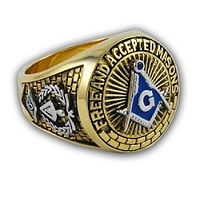Masonic Gloves
Masonic gloves display emblems in some Masonic jurisdictions. In others, they do not.
Why do Freemasons wear Masonic gloves?

Here is what Brother Albert Mackey had to say on the subject:
The following is an excerpt about Freemason gloves from the book, "The Symbolism of Freemasonry: Illustrating and Explaining Its Science and Philosophy, Its Legends, Myths and Symbols by Dr. Albert Gallatin Mackey
The Symbolism of the Gloves:
"The investiture with the gloves is very closely connected with the investiture with the apron, and the consideration of the symbolism of the one naturally follows the consideration of the symbolism of the other.
White Kid Masonic Gloves: In the continental rites of Masonry, as practised in France, in Germany, and in other countries of Europe, it is an invariable custom to present the newly-initiated candidate not only, as we do, with a white leather apron, but also with two pairs of white kid gloves, one a man's pair for himself, and the other a woman's, to be presented by him in turn to his wife or his betrothed, according to the custom of the German masons, or, according to the French, to the female whom he most esteems, which, indeed, amounts, or should amount, to the same thing.
Masonic Gloves..The Works of the Hands: There is in this, of course, as there is in everything else which pertains to Freemasonry, a symbolism.
The gloves given to the candidate for himself are intended to teach him that the acts of a mason should be as pure and spotless as the gloves now given to him. In the German lodges, the word used for acts is of course
handlungen, or handlings, "the works of his hands," which makes
the symbolic idea more impressive."
Masonic Gloves Presentation - 1660
Dr. Robert Plott—no friend of Masonry, but still an historian of much research—says, in his "Natural History of Staffordshire," that the Society of Freemasons, in his time (and he wrote in 1660), presented their candidates with gloves for themselves and their wives.
This shows that the custom still preserved on the continent of Europe was formerly practised in England, although there as well as in America, it is discontinued, which is, perhaps, to be regretted.
But although the presentation of the gloves to the candidate is no longer practised as a ceremony in England or America, yet the use of them as a part of the proper professional clothing of a mason in the duties of the lodge, or in processions, is still retained, and in many well-regulated lodges the members are almost as regularly clothed in their white gloves as in their white aprons.
The symbolism of the gloves, it will be admitted, is, in fact, but a modification of that of the apron. They both signify the same thing; both are allusive to a purification of life. "Who shall ascend," says the Psalmist, "into the hill of the Lord? or who shall stand in his holy place? He that hath clean hands and a pure heart."
The apron may be said to refer to the "pure heart," the gloves to the "clean hands." Both are significant of purification—of that purification which was always symbolized by the ablution which preceded the ancient initiations into the sacred Mysteries.
But while our American and English Masons have adhered only to the apron, and rejected the gloves as a Masonic symbol, the latter appear to be far more important in symbolic science, because the allusions to pure or clean hands are abundant in all the ancient writers.
"Hands," says Wemyss, in his "Clavis Symbolica," "are the
symbols of human actions; pure hands are pure actions; unjust hands are deeds of
injustice." There are numerous references in sacred and profane writers to this
symbolism. The washing of the hands has the outward sign of an internal
purification. Hence the Psalmist says,
"I will wash my hands in innocence, and I will encompass thine altar, Jehovah."
Cleanliness of Hands
In the ancient
Mysteries, the washing of the hands was always an introductory ceremony to the
initiation, and, of course, it was used symbolically to indicate the necessity
of purity from crime as a qualification of those who sought admission into the
sacred rites; and hence on a temple in the Island of Crete this inscription was
placed:
"Cleanse your feet, wash your hands, and then enter."
Indeed, the washing of hands, as symbolic of purity, was among the ancients a peculiarly religious rite. No one dared to pray to the gods until he had cleansed his hands. Thus Homer makes Hector say:
."—Iliad, vi. 266.
"I dread with unwashed hands to bring
My incensed wine to Jove an offering."
In a similar spirit of religion, Æneas, when leaving burning Troy, refuses to enter the temple of Ceres until his hands, polluted by recent strife, had been washed in the living stream.
"Me bello e tanto digressum et cæde recenti,
Attrectare nefas, donec me flumine vivo
Abluero."—Æn. ii. 718.
"In me, now fresh from war and recent strife,
'Tis impious the sacred things to touch
Till in the living stream myself I bathe."
Gloves Worn By Ecclesiasticals
The same practice prevailed among the Jews, and a striking instance of the symbolism is exhibited in that well-known action of Pilate, who, when the Jews clamored for Jesus, that they might crucify him, appeared before the people, and, having taken water, washed his hands, saying at the same time, "I am innocent of the blood of this just man. See ye to it."
White Linen Gloves
In the Christian church of the middle ages, gloves were always worn by bishops or priests when in the performance of ecclesiastical functions. They were made of linen, and were white; and Durandus, a celebrated ritualist, says that:
"by the white gloves were denoted chastity and purity, because the hands were thus kept clean and free from all impurity."
Masonic Gloves...Purity
There is no necessity to extend examples any further. There is no doubt that the use of the gloves in Masonry is a symbolic idea borrowed from the ancient and universal language of symbolism, and was intended, like the apron, to denote the necessity of purity of life.
We have thus traced the gloves and the apron to the same symbolic source. Let us see if we cannot also derive them from the same historic origin.
The apron evidently owes its adoption in Freemasonry to the use of that necessary garment by the operative masons of the middle ages. It is one of the most positive evidences—indeed we may say, absolutely, the most tangible evidence—of the derivation of our speculative science from an operative art.
The builders, who associated in companies, who traversed Europe, and were engaged in the construction of palaces and cathedrals, have left to us, as their descendants, their name, their technical language, and that distinctive piece of clothing by which they protected their garments from the pollutions of their laborious employment. Did they also bequeath to us their gloves?
This is a question which some modern discoveries will at last enable us to solve.
Masonic Gloves of Operative Masons
M. Didron, in his "Annales Archeologiques," presents us with an engraving, copied from the painted glass of a window in the cathedral of Chartres, in France. The painting was executed in the thirteenth century, and represents a number of operative masons at work.
Three of them are adorned with laurel crowns. May
not these be intended to represent the three officers of a lodge? All of the
Masons wear gloves.
M. Didron remarks that in the old documents which he has examined, mention is
often made of gloves which are intended to be presented to masons and
stone-cutters. In a subsequent number of the "Annales," he gives the following
three examples of this fact:—
- In the year 1331, the Chatelan of Villaines, in
Duemois, bought a considerable quantity of gloves, to be given to the
workmen, in order, as it is said, "to shield their hands from the stone and
lime."
- In October, 1383, as he learns from a document of
that period, three dozen pairs of gloves were bought and distributed to the
masons when they commenced the buildings at the Chartreuse of Dijon.
- And, lastly, in 1486 or 1487, twenty-two pair of gloves were given to the masons and stone-cutters who were engaged in work at the city of Amiens.
It is thus evident that the builders...the operative masons...of the Middle ages wore gloves to protect their hands from the effects of their work.
It is equally evident that the speculative Masons have received from their operative predecessors the Masonic gloves, as well as the apron, both of which, being used by the latter for practical uses, have been, in the spirit of symbolism, appropriated by the former to "a more noble and glorious purpose."
End of Albert Mackey's dissertation on Masonic gloves.
I only have 2 things to add to Brother Mackey's excellent discourse upon the historical significance of Masonic gloves.
- Some jurisdictions forbid markings of any kind upon Masonic gloves.
- Customs in some countries may confiscate Masonic gloves due to the markings upon them.
Embroidered Cotton Masonic Gloves
Related Pages
Masonic Emblems & Vehicle Emblems
5 Fast Methods To Find the Information You Want to Learn About
- Search Box - Use the Search Box at the top of your page.
- Site Map - Use my Site Map page to find the topics you are most interested in.
- Carousel - Use the carousel of pages at the top of your screen.
- Menu Icon - On MOBILE, click the MENU button at the top of each page.
- Masonic Books - Browse through a selection of Masonic books.









